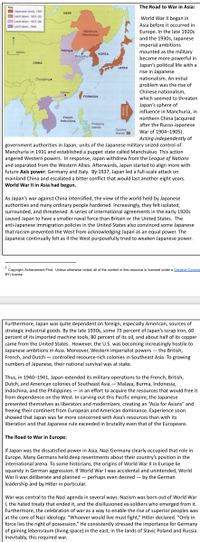Question
What was the cause of the road to World War Two?

Transcribed Image Text:Slowly at first and
Aggression in Europe to 1939
then more
aggressively, Hitler
prepared the
country for war as
he also pursued
NORWAY SWEDEN
Under German
control
September 1, 1939
ESTONIA
Under Italian
control
September 1, 1939
LATVIA
North
Sea
Baltic
LITHUANIA
Maginot Line
IRELAND
DENMARK
Sea
Danzig
territorial
German
concentration
camps, 1939
GREAT
BRITAIN
Sachsenhausen
expansion. A major
NETH.
POUSH CORRIDOR
USSR
GERMANY
BELG.
Buchenwald
POLAND
rearmament
Azimuthal Epad Aa Wetion
250
RHINELAND
LUX March 1936
SUDETENLAND
September 191
Dachau
500 Miles
CZECHOSLOVAKIA
March 1939
(re-militarization)
250
S00 Klometers
program began in
1935. The next
ATLANTIC
Mauthausen
OCEAN
FRANCE
AUSTRIA
SWITZ.
March 1918 HUNGARY
ROMANIA
year, German forces
YUGOSLAVIA
Black Se
entered the
ITALY
BULGARIA
Rhineland, a heavily
CORSICA
SPAIN
ALBANIA
April 1939
industrialized area
SARDINIA
GREECE
TURKEY
Germany used to
control before the
Mediterrancan Sea
SICILY
end of World War I.
Both these actions were in direct defiance of the Treaty of Versailles. Many Germans
saw Hitler's actions as brave and fulfilling a promise to take back Germany's pride. In
1938, Germany annexed (added on) independent Austria and the German-speaking
parts of Czechoslovakia to its territory. On September 1, 1939, Germany unleashed a
devastating attack on Poland, triggering the Second World War in Europe, as Britain and
France declared war on Germany. Quickly defeating France, the Germans launched a
destructive air war against Britain and in 1941 turned their war machine loose on the
Soviet Union. By then, most of Europe was under Nazi control. ?
PORTUGAL

Transcribed Image Text:Key
The Road to War in Asia:
apanese lands, 101
Land taken, 1931-33
Land taken, 1907-38
Land taken, 1940
USSR
World War II began in
Asia before it occurred in
Europe. In the late 1920s
and the 1930s, Japanese
imperial ambitions
mounted as the military
became more powerful in
Japan's political life with a
rise in Japanese
Manchuria
(Manchukuo)
Peking
400km
KOREA
PortArthur
CHINA
JAPAN
Chunging
nationalism. An initial
e
problem was the rise of
Canton
Chinese nationalism,
FORMOSA
which seemed to threaten
Japan's sphere of
influence in Manchuria, in
northern China (acquired
after the Russo-Japanese
War of 1904-1905).
Acting independently of
government authorities in Japan, units of the Japanese military seized control of
Manchuria in 1931 and established a puppet state called Manchukuo. This action
angered Western powers. In response, Japan withdrew from the League of Nations
and separated from the Western Allies. Afterwards, Japan started to align more with
future Axis power: Germany and Italy. By 1937, Japan led a full-scale attack on
mainland China and escalated a bitter conflict that would last another eight years.
French
Indo-China
Philippine
Islands
Caroline
Islands
World War Il in Asia had begun.
As Japan's war against China intensified, the view of the world held by Japanese
authorities and many ordinary people hardened. Increasingly, they felt isolated,
surrounded, and threatened. A series of international agreements in the early 1920s
caused Japan to have a smaller naval force than Britain or the United States. The
anti-Japanese immigration policies in the United States also convinced some Japanese
that racism prevented the West from acknowledging Japan as an equal power. The
Japanese continually felt as if the West purposefully tried to weaken Japanese power.
1
Copyright: Achievement First. Unless otherwise noted, all of the content in this resource is licensed under a Creafive Commo
BY) license
Furthermore, Japan was quite dependent on foreign, especially American, sources of
strategic industrial goods. By the late 1930s, some 73 percent of Japan's scrap iron, 60
percent of its imported machine tools, 80 percent of its oil, and about half of its copper
came from the United States. However, the U.S. was becoming increasingly hostile to
Japanese ambitions in Asia. Moreover, Western imperialist powers – the British,
French, and Dutch – controlled resource-rich colonies in Southeast Asia. To growing
numbers of Japanese, their national survival was at stake.
Thus, in 1940-1941, Japan extended its military operations to the French, British,
Dutch, and American colonies of Southeast Asia – Malaya, Burma, Indonesia,
Indochina, and the Philippines – in an effort to acquire the resources that would free it
from dependence on the West. In carving out this Pacific empire, the Japanese
presented themselves as liberators and modernizers, creating an "Asia for Asians" and
freeing their continent from European and American dominance. Experience soon
showed that Japan was far more concerned with Asia's resources than with its
liberation and that Japanese rule exceeded in brutality even that of the Europeans.
The Road to War in Europe:
If Japan was the dissatisfied power in Asia, Nazi Germany clearly occupied that role in
Europe. Many Germans held deep resentments about their country's position in the
international arena. To some historians, the origins of World War Il in Europe lie
squarely in German aggression. If World War I was accidental and unintended, World
War Il was deliberate and planned - perhaps even desired – by the German
leadership and by Hitler in particular.
War was central to the Nazi agenda in several ways. Nazism was born out of World War
I, the hated treaty that ended it, and the disillusioned ex-soldiers who emerged from it.
Furthermore, the celebration of war as a way to enable the rise of superior peoples was
at the core of Nazi ideology. "Whoever would live must fight," Hitler declared. "Only in
force lies the right of possession." He consistently stressed the importance for Germany
of gaining lebensraum (living space) in the east, in the lands of Slavic Poland and Russia.
Inevitably, this required war.
Expert Solution
This question has been solved!
Explore an expertly crafted, step-by-step solution for a thorough understanding of key concepts.
This is a popular solution
Trending nowThis is a popular solution!
Step by stepSolved in 3 steps
